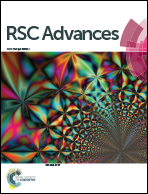Comparison of the scavenging capacities of phloroglucinol and 2,4,6-trihydroxypyridine towards HO˙ radical: a computational study†
Abstract
In this work the scavenging capacities of biologically active phloroglucinol (1,3,5-trihydroxybenzene, THB–OH) and structurally similar 2,4,6-trihydroxypyridine (THP–OH) towards HO˙ were examined. This task was realized by means of density functional theory, through investigation of all favorable antioxidative pathways in two solvents of different polarity: benzene and water. It was found that in benzene both compounds conform to the hydrogen atom transfer (HAT) and radical adduct formation (RAF) mechanisms. In water, the mechanisms of antioxidative action of the investigated compounds are far more complex, especially those of THB–OH. This compound and HO˙ undergo all four investigated mechanisms: HAT, RAF, sequential proton loss electron transfer (SPLET), and single electron transfer-proton transfer (SET-PT). HAT, RAF and SPLET are operative mechanisms in the case of THP–OH. Independently of solvent polarity, both investigated compounds are more reactive towards HO˙ in comparison to Trolox. Our final remark is as follows: the electron-withdrawing effect of the nitrogen is stronger than the electron-donating effect of the OH groups in the molecule of THP–OH. As a consequence, THB–OH is more powerful antioxidant than THP–OH, thus implying that the presence of nitrogen decreases the scavenging capacity of the respective compound.



 Please wait while we load your content...
Please wait while we load your content...